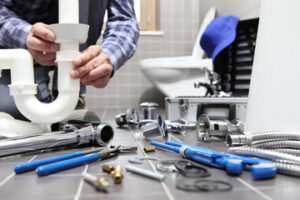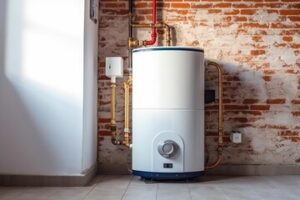Plumber In Glendora installs, repairs and maintains pipes that provide water, heat and sewage for homes and businesses. They also inspect these systems to ensure they comply with building codes and safety protocols.

To become a plumber, you’ll need to complete an apprenticeship and pass a licensing exam. Some states also require you to carry workers’ compensation, liability and unemployment insurance.
A dripping faucet is one of the most common and annoying household plumbing problems. Many homeowners attempt to fix the problem themselves, but if the repair is not successful, it may be time to call a plumber. A plumber has tools and experience that can make the job much easier. They can also offer advice about other potential problems that you might face.
There are several things that can cause a leaky faucet, including loosening of the screws or bolts that hold the handle in place or corrosion on the parts. If the valve cartridge is defective, it could also be to blame for a leak. A plumber can replace the cartridge and ensure that it is oriented properly.
The most likely cause of a leaky faucet is a loose packing nut. This nut holds the stem in place and is usually tightened with a spanner tool included in a repair kit. Loosening the nut can help stop the leak and may even restore your water pressure.
You can also try to fix a leaking faucet by removing the handle and cleaning the parts underneath. This should remove any dirt and mineral buildup that can cause a leak. A corroded washer or O-ring may also be to blame for the leak. You can purchase replacement washers and O-rings at a hardware store. Make sure that you get the correct size, as a mismatched washer or O-ring can lead to further leaks.
Once the washer and O-ring are replaced, you can reassemble the faucet and turn the water back on. You may have to wait a few minutes for the water to fully run through and heat up. You can then test the faucet for leaks. If the leak persists, you can call a plumber for more complex repairs.
It is also possible that the leaking is caused by a broken pipe behind the sink. This is a more serious issue that requires professional assistance from a plumber. They will be able to track down the source of the leak and fix it.
Squeaky Faucets
Squeaky faucets can be annoying, but they’re usually easy to fix. The most common cause of a squeaky faucet is when the handle’s valve stem rubs against the inside of the faucet body. This creates a high-pitched whistling noise that can be heard by anyone who uses the sink. To fix this, the plumber will remove the faucet handle and inspect the components for damage or build-up. They may also clean the valve cavity to prevent further problems. If there is a major issue, the plumber will replace the faucet handle and valve stem.
Before attempting to fix the problem, it’s important to turn off the water supply to the faucet. This will prevent any further flooding or damage and will help you avoid a dangerous situation. Once the water is turned off, you can begin by removing the faucet handle. This can be done by loosening the screw or fastener with a screwdriver and pulling it off. If there is a decorative cap covering the screw, it can be removed by prying it off with a screwdriver or your fingernail.
Once the handle is removed, you’ll have better access to the interior of the faucet. It’s helpful to blow compressed air into the faucet to dislodge any debris that may be clogging it. Then, it’s time to lubricate the parts to reduce friction and silence the squeak. To do this, use a plumber’s grease or a lubricant designed for plumbing applications. Apply the lubricant liberally to all visible areas of the handle stem. Be sure to remove any excess lubricant, as this can attract dirt or debris and lead to further problems.
After lubricating the handle stem, you’ll need to reassemble the faucet and test it out. If the squeaking continues, you may need to remove the handle stem and clean or replace the washer. It’s also possible that the threads in the faucet body are worn out and need to be replaced. This is a more involved job that requires a ball socket wrench and a replacement stem for your specific faucet.
Faucets That Don’t Turn On
A faucet that won’t turn on can be frustrating, but it’s also often an easy fix. First, you’ll want to make sure that the water supply is turned off. This can be done by locating the shut-off valves under your sink and turning them counterclockwise until they are completely closed. This will prevent any accidental flooding while you’re working on the faucet.
Then, you’ll need to inspect the faucet handle and cartridge to see if any components are damaged or worn out. In many cases, this will simply involve removing the handle and cleaning or replacing any parts that are worn out or damaged. After reassembly, the faucet should be ready to turn on!
If your faucet is still hard to turn, it’s time to call in a professional. Plumbers can conduct a complete assessment of the issue and recommend the best course of action. They’ll have the necessary tools and knowledge to fix your faucet correctly and quickly.
In some cases, a hard-to-turn faucet may be caused by an underlying problem within the plumbing system. This could be a result of a dislodged or broken piece, mineral buildup, or even damage to the valve body itself. These issues may require a more in-depth inspection and repair to fix.
Before you call a plumber, try switching the handle up and down, and side-to-side to see if this makes any difference. If the faucet is still difficult to turn, it’s likely due to a more serious problem that requires a professional plumber to resolve.
If your faucet isn’t turning on, it’s important to take the proper steps to shut off the water supply and inspect the cartridge or valve for damage. By following these tips, you can save yourself the frustration of a stubborn faucet and avoid costly repairs in the future!
Faucets That Don’t Drain
One of the most annoying problems a homeowner can experience is when a faucet doesn’t drain. This can happen for any number of reasons, and it’s important to troubleshoot the problem to find the cause so that it can be repaired. Here are a few things to try before calling a plumber:
First, make sure that the faucet’s water supply is actually turned off. Look under the sink for shut-off valves; these are usually small handles that, when turned clockwise, will turn off the water flow to your sink. If there aren’t any, you’ll need to turn off your home’s main water valve.
If the faucet still doesn’t drain, you may need to replace the cartridge in the stem or even the entire faucet assembly. Make sure you are replacing the correct parts, as mismatched components can lead to leaks. When installing a new faucet, it is also a good idea to coat the entire lip of the drain with silicone or plumber’s putty to ensure a tight seal.
Another common reason for a non-draining faucet is that the P-trap has become blocked or filled with sediment. A plumbing professional can clean the P-trap to ensure it’s working properly.
Leaking Around the Base
Water leaking from the base of your faucet can be caused by a worn O-ring or gasket. It can also be caused by a loose valve stem or cartridge. Leaving a leaking faucet unrepaired for long periods of time can cause mold and mildew to grow, which can contaminate your household water.
Leaking at the Stem
The easiest way to diagnose a leaky faucet stem is to check the washer and seat. The washer creates a watertight seal when the handle is in the off position, and if it wears out or becomes damaged, water can seep through and drip from the faucet spout. Replace the washer or seat as needed, and be sure to use an exact replacement to prevent leaks from occurring again.
A dripping faucet is not only noisy, but it can cost you money. A steady drip can waste $20 or more in water per month, and it’s important to have it repaired as soon as possible. Fortunately, most homeowner’s are able to perform a simple at-home fix to remedy this common problem. However, if the issue remains, a professional plumber can assist with further repairs.

